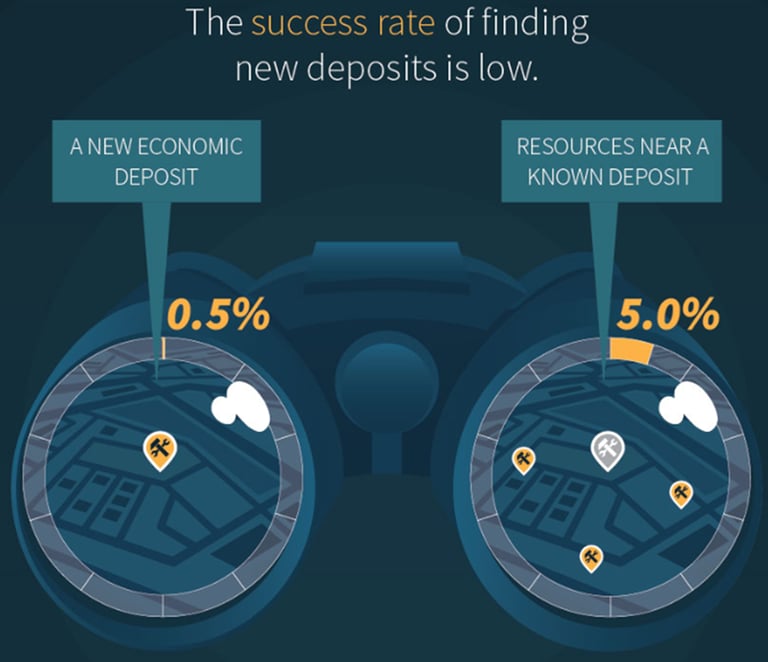How AI and Big Data Will Unlock the Next Wave of Mineral Discoveries
Xuan-Ce Wang
5/19/20254 min read


The article explores the transformative role of artificial intelligence (AI) and big data in the field of mineral exploration. As global demand for critical minerals increases, traditional exploration methods—often described as more art than science—are being enhanced by technology to improve efficiency and success rates. This analysis delves into how AI is reshaping the mineral exploration industry, examining its implications for efficiency and cost-effectiveness, the challenges it presents, its impact on employment, and the ethical considerations it raises.
Efficiency and Cost-Effectiveness
Mineral exploration is a high-stakes endeavor with a historically low success rate: the article notes that only 0.5% of exploration efforts result in a new deposit, though this improves to 5% near known resources. The process generates vast amounts of data—terabytes from soil samples, drill results, geochemistry, and assay analyses—which has traditionally been analyzed manually, a slow and labor-intensive task. AI revolutionizes this by rapidly processing these datasets to identify patterns and anomalies indicative of potential mineral deposits. For instance, each drill hole produces approximately 200 megabytes of data, and a single project can amass terabytes. AI's ability to sift through this information quickly and accurately increases the odds of discovery by highlighting areas with characteristics similar to past finds.
This efficiency translates into significant cost savings. The article cites data from 2005 to 2014, showing that exploration expenditures often exceeded the value of discoveries, underscoring the financial risk involved. AI mitigates this by enabling a targeted approach: instead of drilling broadly, companies can focus on high-potential sites identified by data-driven models. This reduces wasted resources and enhances the return on investment, making exploration more economically viable. By transforming exploration into a more precise science, AI promises to unlock new mineral resources within budget constraints, addressing the growing need for materials essential to modern technologies.
Challenges of Implementing AI
While AI offers substantial benefits, its adoption in mineral exploration is not without hurdles. A primary challenge is data quality. AI models rely on accurate, comprehensive, and unbiased data to generate reliable predictions. If the input data—drawn from diverse sources like geological surveys, geophysical readings, and geochemical analyses—is incomplete or flawed, the resulting insights may lead to erroneous exploration decisions. Ensuring data integrity requires rigorous collection and validation processes, which can be resource intensive.
Another obstacle is the computational power needed to handle the massive datasets involved. Processing terabytes of data demands advanced infrastructure, including high-performance computing systems, which may be cost-prohibitive for smaller exploration firms. This could create an uneven playing field, favoring larger, well-funded companies and potentially widening industry disparities.
Finally, data integration poses a technical challenge. Mineral exploration data is heterogeneous, combining structured (e.g., numerical assay results) and unstructured (e.g., geological observations) formats. Developing algorithms that effectively synthesize these diverse data types into cohesive models requires significant expertise and innovation, adding complexity to AI implementation.
Impact on Employment
The integration of AI into mineral exploration prompts speculation about its effects on the workforce. At first glance, automating data analysis might suggest a reduction in jobs, particularly for roles focused on processing and interpreting raw data. However, the article references Professor Ajay Agrawal’s framework, which divides human activities into five categories: data collection, processing, prediction, judgment, and action. Agrawal argues that machines excel at processing and prediction, while humans remain essential for judgment and decision-making. In this context, AI does not replace geologists but augments their capabilities, freeing them from repetitive tasks to focus on strategic interpretation and planning.
Moreover, AI introduces new opportunities. As exploration becomes more data-driven, demand grows for professionals skilled in data science, machine learning, and AI development. These roles complement traditional geology positions, fostering interdisciplinary teams that blend technical and scientific expertise. Rather than diminishing employment, AI could shift the industry toward a more skilled, technology-oriented workforce, enhancing productivity and innovation.
Ethical Considerations
The use of AI in mineral exploration also raises ethical questions, particularly regarding environmental impact. Mining can disrupt ecosystems, especially in sensitive areas, and AI’s ability to accelerate deposit discovery might exacerbate this if not managed responsibly. However, AI also offers solutions: by optimizing exploration and extraction, it could minimize environmental footprints—for example, identifying deposits in less ecologically vulnerable regions or enabling precision mining techniques that reduce land disturbance. The challenge lies in ensuring that AI is deployed with sustainability as a priority, balancing resource needs with ecological preservation.
Another ethical concern is resource equity. AI’s efficiency could disproportionately benefit large corporations able to invest in the technology, concentrating wealth and influence. This risks marginalizing smaller firms and communities dependent on mineral resources. To address this, policies or partnerships could promote access to AI tools, ensuring that the economic advantages of new discoveries are shared more equitably across stakeholders.
Conclusion
AI and big data are ushering in a new era for mineral exploration, shifting it from an art of intuition to a science of precision. By processing vast geological datasets, AI enhances efficiency and cost-effectiveness, offering a higher success rate and lower financial risk in meeting the world’s mineral demands. Yet, its potential is tempered by challenges such as data quality, computational demands, and integration complexities. Employment impacts are nuanced, with AI likely to redefine rather than eliminate jobs, creating a need for new skills while preserving the geologist’s critical role. Ethically, AI presents both opportunities and risks, necessitating a careful approach to environmental and equitable considerations.
As the industry embraces these technologies, the key will be to harness AI’s power responsibly. With the right strategies—ensuring data integrity, democratizing access to technology, and prioritizing sustainability—mineral exploration can evolve into a more effective and ethical pursuit, unlocking Earth’s resources for the benefit of all.








